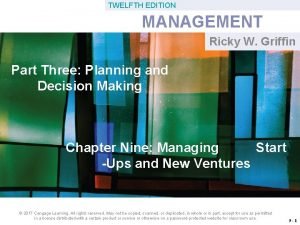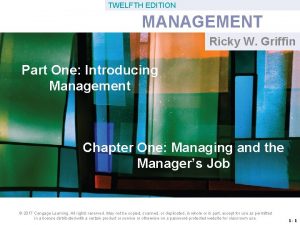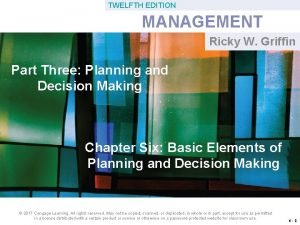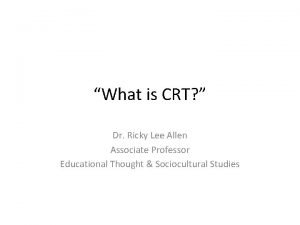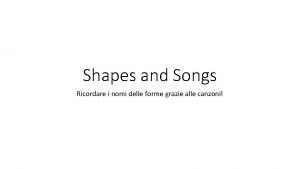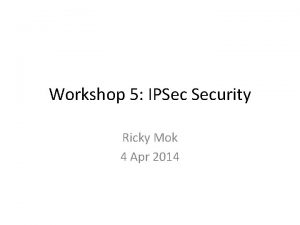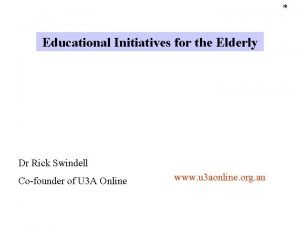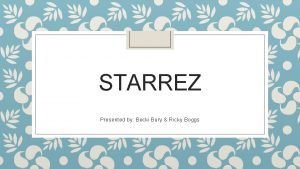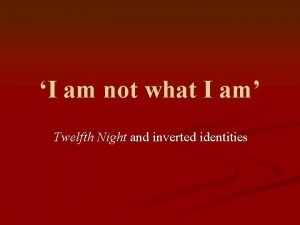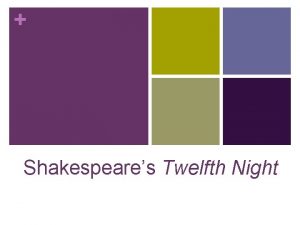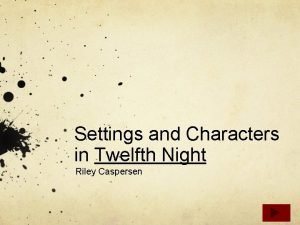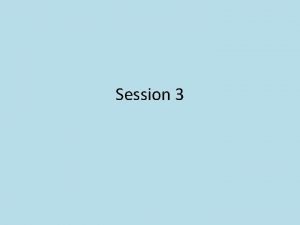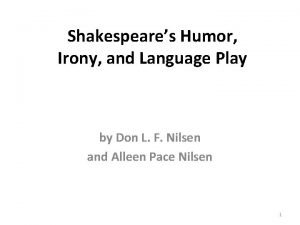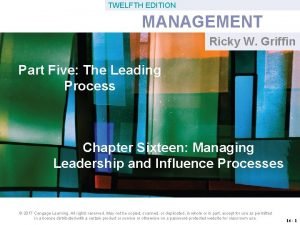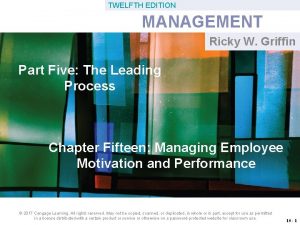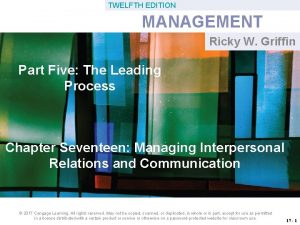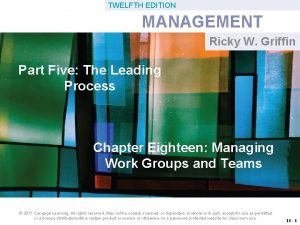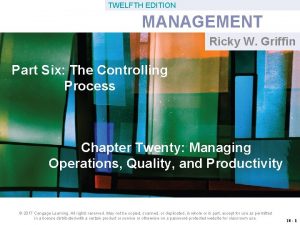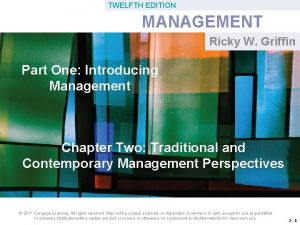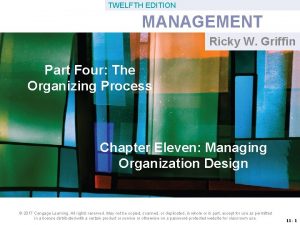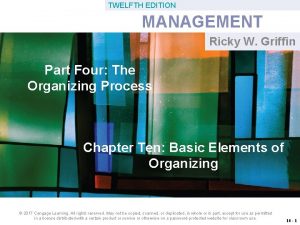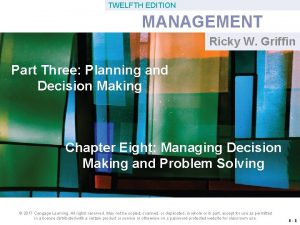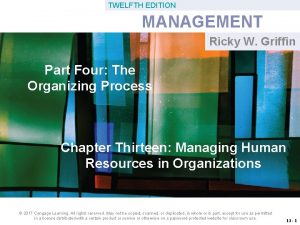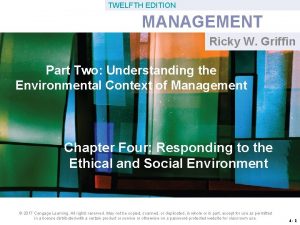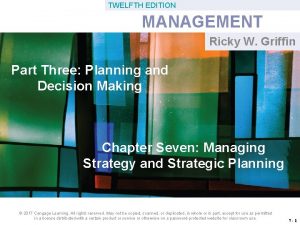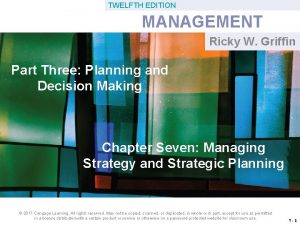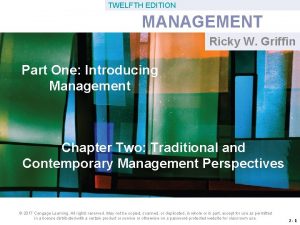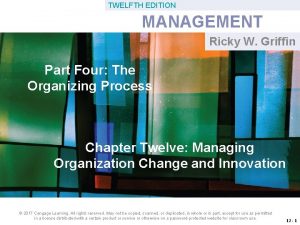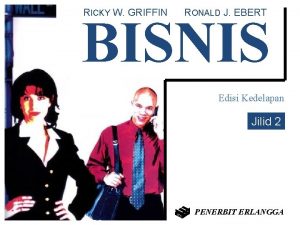TWELFTH EDITION MANAGEMENT Ricky W Griffin Part Five

































- Slides: 33

TWELFTH EDITION MANAGEMENT Ricky W. Griffin Part Five: The Leading Process Chapter Fourteen: Basic Elements of Individual Behavior in Organizations © 2017 Cengage Learning. All rights reserved. May not be copied, scanned, or duplicated, in whole or in part, except for use as permitted in a license distributed with a certain product or service or otherwise on a password-protected website for classroom use. 14 - 1

Learning Outcomes 1. Explain the nature of the individual – organization relationship. 2. Define personality and describe personality attributes that affect behavior in organizations. 3. Discuss individual attitudes in organizations and how they affect behavior. 4. Describe basic perceptual processes and the role of attributions in organizations. 5. Discuss the causes and consequences of stress and describe how it can be managed. 6. Describe creativity and its role in organizations. 7. Explain how workplace behaviors can directly or indirectly influence organizational effectiveness. © 2017 Cengage Learning. All rights reserved. May not be copied, scanned, or duplicated, in whole or in part, except for use as permitted in a license distributed with a certain product or service or otherwise on a password-protected website for classroom use. 14 - 2

Understanding Individuals in Organizations § Psychological contract – is the overall set of expectations held by an individual with respect to their contributions to the organization and what the organization will provide in return. – The individual provides contributions such as effort, skill, ability, time, or loyalty. – The organization provides inducements both tangible (pay) and intangible (status). © 2017 Cengage Learning. All rights reserved. May not be copied, scanned, or duplicated, in whole or in part, except for use as permitted in a license distributed with a certain product or service or otherwise on a password-protected website for classroom use. 14 - 3

Figure 14. 1 The Psychological Contract The psychological contract is not written on paper nor are the terms negotiated. © 2017 Cengage Learning. All rights reserved. May not be copied, scanned, or duplicated, in whole or in part, except for use as permitted in a license distributed with a certain product or service or otherwise on a password-protected website for classroom use. 14 - 4

Understanding Individuals in Organizations § Person-job fit – is the extent to which the individual contributions match the organizational inducements. – Possible reasons for imperfect person-job fit: • Organizational selection procedures are imperfect. • Both people and organizations change. • Each individual is unique. § Individual differences – are personal attributes that vary from one person to another. © 2017 Cengage Learning. All rights reserved. May not be copied, scanned, or duplicated, in whole or in part, except for use as permitted in a license distributed with a certain product or service or otherwise on a password-protected website for classroom use. 14 - 5

Personality and Individual Behavior Personality The relatively permanent set of psychological and behavioral attributes that distinguish one person from another. Managers should strive to understand basic personality attributes. © 2017 Cengage Learning. All rights reserved. May not be copied, scanned, or duplicated, in whole or in part, except for use as permitted in a license distributed with a certain product or service or otherwise on a password-protected website for classroom use. 14 - 6

“Big Five” Personality Traits Agreeableness • A person’s ability to get along with others. Conscientiousness • The number of things a person can effectively work on at one time. Negative emotionality • Extent to which a person is poised, calm, resilient, and secure. Extraversion • A person’s comfort level with relationships. Openness • A person’s rigidity of beliefs and range of interests. © 2017 Cengage Learning. All rights reserved. May not be copied, scanned, or duplicated, in whole or in part, except for use as permitted in a license distributed with a certain product or service or otherwise on a password-protected website for classroom use. 14 - 7

Figure 14. 2 The “Big Five” Model of Personality © 2017 Cengage Learning. All rights reserved. May not be copied, scanned, or duplicated, in whole or in part, except for use as permitted in a license distributed with a certain product or service or otherwise on a password-protected website for classroom use. 14 - 8

The Myers-Briggs Framework § Extraversion (E) versus Introversion (I) – Extraverts gather energy from others, introverts need solitude to recharge their energy. § Sensing (S) versus Intuition (N) – Sensing types prefer concrete ideas, intuitive types prefer abstract concepts. § Thinking (T) versus Feeling (F) – Thinkers base decisions on logic, feelers on emotion. § Judging (J) versus Perceiving (P) – Judgers prefer completion, perceivers enjoy the process. © 2017 Cengage Learning. All rights reserved. May not be copied, scanned, or duplicated, in whole or in part, except for use as permitted in a license distributed with a certain product or service or otherwise on a password-protected website for classroom use. 14 - 9

Other Personality Traits at Work § Locus of control – is the degree an individual believes their behavior directly impacts the consequences of that behavior. • Internal locus of control is a belief that success/failure results from one’s own behavior. • External locus of control is a belief that success/failure results from fate, chance, luck, or the behavior of others. § Self-efficacy – is an individual’s beliefs about her or his capabilities to perform a task. © 2017 Cengage Learning. All rights reserved. May not be copied, scanned, or duplicated, in whole or in part, except for use as permitted in a license distributed with a certain product or service or otherwise on a password-protected website for classroom use. 14 - 10

Other Personality Traits at Work § Authoritarianism – is an individual’s belief that power and status differences are appropriate in an organization. § Machiavellianism – is behavior directed at gaining power and controlling behavior of others. § Self-esteem – is the extent to which a person believes they are worthwhile and a deserving individual. § Risk propensity – is the degree to which an individual is willing to take chances and make risky decisions. © 2017 Cengage Learning. All rights reserved. May not be copied, scanned, or duplicated, in whole or in part, except for use as permitted in a license distributed with a certain product or service or otherwise on a password-protected website for classroom use. 14 - 11

Emotional Intelligence § Emotional intelligence or EQ – is the extent to which people are self-aware, manage their emotions, motive themselves, express empathy, and possess social skills. – Research suggest persons with high EQ may perform better than others. – EQ appears to be something not biologically based, it can be developed within a person. © 2017 Cengage Learning. All rights reserved. May not be copied, scanned, or duplicated, in whole or in part, except for use as permitted in a license distributed with a certain product or service or otherwise on a password-protected website for classroom use. 14 - 12

Emotional Intelligence Selfawareness Managing emotions Empathy Motivating oneself Social skills There are five dimensions of EQ. © 2017 Cengage Learning. All rights reserved. May not be copied, scanned, or duplicated, in whole or in part, except for use as permitted in a license distributed with a certain product or service or otherwise on a password-protected website for classroom use. 14 - 13

Attitudes and Individual Behavior § Attitudes – are complexes of beliefs/feelings people have about specific ideas, situations, or other people. • The affective component reflects feelings and emotions an individual has toward a situation. • The cognitive component derives from perceived knowledge an individual has about a situation. • The intentional component reflects how an individual expects to behave toward or in the situation. – Cognitive dissonance occurs when an individual has conflicting attitudes. © 2017 Cengage Learning. All rights reserved. May not be copied, scanned, or duplicated, in whole or in part, except for use as permitted in a license distributed with a certain product or service or otherwise on a password-protected website for classroom use. 14 - 14

Work-Related Attitudes § Job satisfaction or dissatisfaction – reflects the extent an individual is gratified by or fulfilled by their work. § Organizational commitment – reflects an individual’s identification with and attachment to the organization. § Organizational engagement – is the extent an employee sees themselves as part of the organization, actively looks for ways to contribute, and is involved in multiple ways. © 2017 Cengage Learning. All rights reserved. May not be copied, scanned, or duplicated, in whole or in part, except for use as permitted in a license distributed with a certain product or service or otherwise on a password-protected website for classroom use. 14 - 15

Affect and Mood in Organizations § Positive affectivity – is a tendency to be upbeat and optimistic, have an overall sense of well-being, see things in a positive light, and seem to be in a good mood. § Negative affectivity – is a tendency to be generally downbeat and pessimistic, see things in a negative way, and seem to be in a bad mood. © 2017 Cengage Learning. All rights reserved. May not be copied, scanned, or duplicated, in whole or in part, except for use as permitted in a license distributed with a certain product or service or otherwise on a password-protected website for classroom use. 14 - 16

Perception and Individual Behavior Perception Is the set of processes by which an individual becomes aware of and interprets information about the environment. Because perception plays a role in a variety of other workplace behaviors, managers need to have a general understanding of basic perceptual processes. © 2017 Cengage Learning. All rights reserved. May not be copied, scanned, or duplicated, in whole or in part, except for use as permitted in a license distributed with a certain product or service or otherwise on a password-protected website for classroom use. 14 - 17

Basic Perceptual Processes § Selective perception – is the process of screening out information we are uncomfortable with or that contradicts our beliefs. – Helpful only if our basic perception is accurate. § Stereotyping – is the process of categorizing or labeling people on the basis of a single attribute. – Common attributes include race, gender, and age. © 2017 Cengage Learning. All rights reserved. May not be copied, scanned, or duplicated, in whole or in part, except for use as permitted in a license distributed with a certain product or service or otherwise on a password-protected website for classroom use. 14 - 18

Figure 14. 3 Perceptual Processes Two of the most basic perceptual processes are selective perception and stereotyping. © 2017 Cengage Learning. All rights reserved. May not be copied, scanned, or duplicated, in whole or in part, except for use as permitted in a license distributed with a certain product or service or otherwise on a password-protected website for classroom use. 14 - 19

Perception and Attribution § Attribution – is a mechanism through which we observe behavior and attribute causes to it. – May be our own behavior, or that of others. – Occurs through three forces: • Consensus is the extent other people in the same situation behave the same way. • Consistency is the extent the same person behaves in the same way at different times. • Distinctiveness is the extent the same person behaves in the same way in other situations. © 2017 Cengage Learning. All rights reserved. May not be copied, scanned, or duplicated, in whole or in part, except for use as permitted in a license distributed with a certain product or service or otherwise on a password-protected website for classroom use. 14 - 20

Stress and Individual Behavior § Stress – is an individual’s response to a strong stimulus, called a stressor. § General Adaptation Syndrome (GAS) – is a general cycle of the stress process. • Stage 1 – alarm. • Stage 2 – resistance. • Stage 3 – exhaustion. © 2017 Cengage Learning. All rights reserved. May not be copied, scanned, or duplicated, in whole or in part, except for use as permitted in a license distributed with a certain product or service or otherwise on a password-protected website for classroom use. 14 - 21

Figure 14. 4 The General Adaptation Syndrome Stress is not all bad. The absence of stress may lead to stagnation. © 2017 Cengage Learning. All rights reserved. May not be copied, scanned, or duplicated, in whole or in part, except for use as permitted in a license distributed with a certain product or service or otherwise on a password-protected website for classroom use. 14 - 22

Stress and Individual Behavior Type A Type B • Individuals are competitive, devoted to work, and have a strong sense of time urgency. • Individuals are less competitive, less devoted to work, and have a weaker sense of time urgency. Type B people are less likely to experience stress. © 2017 Cengage Learning. All rights reserved. May not be copied, scanned, or duplicated, in whole or in part, except for use as permitted in a license distributed with a certain product or service or otherwise on a password-protected website for classroom use. 14 - 23

Causes and Consequences of Stress § Four categories of work-related stressors – Task demands are associated with the task itself. – Physical demands are stressors associated with the job setting. – Role demands are stressors associated with roles within the organization. – Interpersonal demands are associated with relationships that confront people. © 2017 Cengage Learning. All rights reserved. May not be copied, scanned, or duplicated, in whole or in part, except for use as permitted in a license distributed with a certain product or service or otherwise on a password-protected website for classroom use. 14 - 24

Figure 14. 5 Causes of Work Stress © 2017 Cengage Learning. All rights reserved. May not be copied, scanned, or duplicated, in whole or in part, except for use as permitted in a license distributed with a certain product or service or otherwise on a password-protected website for classroom use. 14 - 25

Causes and Consequences of Stress § Negative consequences of stress – Behavioral – include detrimental or harmful actions. – Psychological – include sleep disturbances, depression and family problems. – Medical – include heart disease, stroke, etc. – Has direct consequences for businesses. – Burnout • is a feeling of exhaustion that may develop when someone experiences prolonged stress. © 2017 Cengage Learning. All rights reserved. May not be copied, scanned, or duplicated, in whole or in part, except for use as permitted in a license distributed with a certain product or service or otherwise on a password-protected website for classroom use. 14 - 26

Managing Stress § People manage stress through exercise, relaxation, time management, and support. § Organizations help employees cope with stress through: – wellness programs, stress management programs, health promotion programs, and fitness programs. © 2017 Cengage Learning. All rights reserved. May not be copied, scanned, or duplicated, in whole or in part, except for use as permitted in a license distributed with a certain product or service or otherwise on a password-protected website for classroom use. 14 - 27

Creativity in Organizations Creativity The ability of an individual to generate new ideas or conceive of new perspectives on existing ideas. © 2017 Cengage Learning. All rights reserved. May not be copied, scanned, or duplicated, in whole or in part, except for use as permitted in a license distributed with a certain product or service or otherwise on a password-protected website for classroom use. 14 - 28

The Creative Individual § Creative attributes fall into three categories: – background experiences, personal traits, and cognitive abilities. • Creative individuals were often raised in an environment that nurtured creativity. • Creative people share traits of openness, high energy, independence and autonomy. • Creative people are intelligent and show divergent (see differences) and convergent thinking skills (see similarities). © 2017 Cengage Learning. All rights reserved. May not be copied, scanned, or duplicated, in whole or in part, except for use as permitted in a license distributed with a certain product or service or otherwise on a password-protected website for classroom use. 14 - 29

Creativity in Organizations § The creative process – Preparation – education and experiences. – Incubation – allow the problem to mature. – Insight – a spontaneous breakthrough. – Verification – determines validity of insight. § Enhancing creativity in organizations – Make it a part of the firm’s culture. – Integrate into the reward system. © 2017 Cengage Learning. All rights reserved. May not be copied, scanned, or duplicated, in whole or in part, except for use as permitted in a license distributed with a certain product or service or otherwise on a password-protected website for classroom use. 14 - 30

Types of Workplace Behavior § Workplace behavior – is a pattern of action by the members of an organization that directly or indirectly influences organizational effectiveness. – Performance behaviors • are the total set of work-related behaviors the organization expects the individual to display. – Withdrawal behavior • Absenteeism – when someone skips work. • Turnover – when someone quits work. © 2017 Cengage Learning. All rights reserved. May not be copied, scanned, or duplicated, in whole or in part, except for use as permitted in a license distributed with a certain product or service or otherwise on a password-protected website for classroom use. 14 - 31

Types of Workplace Behavior § Organizational citizenship – refers to the behavior of individuals that make a positive overall contribution to the organization. • Likely a complex mosaic of individual, social and organizational variables. § Dysfunctional behaviors – are those that detract from, rather than contribute to, organizational performance. • Includes absenteeism and turnover, theft, sabotage, harassment, political behavior, and violence. © 2017 Cengage Learning. All rights reserved. May not be copied, scanned, or duplicated, in whole or in part, except for use as permitted in a license distributed with a certain product or service or otherwise on a password-protected website for classroom use. 14 - 32

Summary § The chapter first investigated the psychological nature of individuals. § The concept of personality, and several attributes, were introduced. § The role of stress was discussed, followed by a discussion on creativity. § The chapter concluded by describing a number of basic individual behaviors important to organizations. © 2017 Cengage Learning. All rights reserved. May not be copied, scanned, or duplicated, in whole or in part, except for use as permitted in a license distributed with a certain product or service or otherwise on a password-protected website for classroom use. 14 - 33
 Ricky w griffin management 12th edition
Ricky w griffin management 12th edition Management 12th edition griffin
Management 12th edition griffin Management ricky griffin 12th edition
Management ricky griffin 12th edition Management ricky griffin 12th edition
Management ricky griffin 12th edition Ricky pedersen
Ricky pedersen Ricky lee allen
Ricky lee allen Ricky rectangle is my name
Ricky rectangle is my name Ricky punzalan
Ricky punzalan Ricky mok
Ricky mok Ricky swindell
Ricky swindell Starrez training
Starrez training Chemistry augmented reality
Chemistry augmented reality Mis chapter 6
Mis chapter 6 Using mis (10th edition)
Using mis (10th edition) Night structure
Night structure Twelfth night ppt
Twelfth night ppt Cesario come for so you shall be
Cesario come for so you shall be Twelfth night characters
Twelfth night characters Dramatic techniques in twelfth night
Dramatic techniques in twelfth night Twelfth night act 1 scene 5 translation
Twelfth night act 1 scene 5 translation I am not what i am twelfth night
I am not what i am twelfth night Themes in twelfth night
Themes in twelfth night Twelfth song of thunder figurative language
Twelfth song of thunder figurative language Twelfth night act 5
Twelfth night act 5 Stock characters in twelfth night
Stock characters in twelfth night Jenny phelps
Jenny phelps Msik
Msik Satire in twelfth night
Satire in twelfth night Deverell twelfth night
Deverell twelfth night Disappeared silent night
Disappeared silent night Comedy vs tragedy shakespeare
Comedy vs tragedy shakespeare And now with gleams of half-extinguished thought
And now with gleams of half-extinguished thought Five of five
Five of five 5 elements and 5 senses
5 elements and 5 senses
